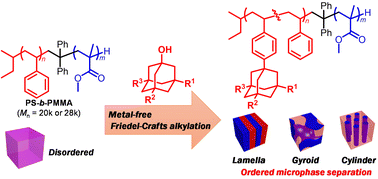Installation of the adamantyl group in polystyrene-block-poly(methyl methacrylate) via Friedel–Crafts alkylation to modulate the microphase-separated morphology and dimensions†
Abstract
Although polystyrene-block-poly(methyl methacrylate) (PS-b-PMMA) is the most widely employed template and scaffold for constructing nanoscale patterns, its relatively small Flory–Huggins interaction parameter makes it challenging to realize microphase-separated structures with a periodicity (or domain spacing) of less than 20 nm. The direct post-polymerization modification of PS-b-PMMA can resolve this issue. In this study, we present the PS block post-polymerization modification of commercially available PS-b-PMMA through a metal-free Friedel–Crafts alkylation reaction with adamantanols to modulate its microphase-separated morphology and dimensions. The adamantyl group can be easily installed on the PS benzene ring, which increases the incompatibility with the PMMA block, enabling ordered microphase-separated structures, including lamellar, gyroid and hexagonally close-packed cylindrical structures, from low-molecular-weight PS-b-PMMA. Notably, a periodicity as low as approximately 16 nm was realized with this strategy, which is much lower than the lowest accessible periodicity of pristine PS-b-PMMA. Furthermore, we observed additional benefits from the installation of the adamantyl group, such as increased thermal stability, glass transition temperature and etching contrast.

- This article is part of the themed collection: Polymer Chemistry Emerging Investigators Series


 Please wait while we load your content...
Please wait while we load your content...